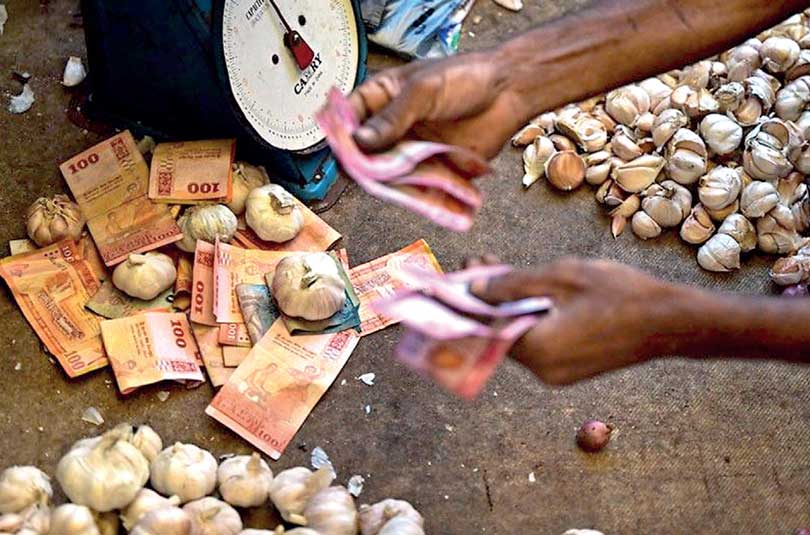Saturday Dec 13, 2025
Saturday Dec 13, 2025
Tuesday, 28 May 2024 01:48 - - {{hitsCtrl.values.hits}}

Unless we ask more and better questions of those who want to rule us, history may repeat
 A few days ago, I attended the launch of a policy platform by an organisation called Piripun Deshayak where the audience included at least one Presidential Candidate. I was quite surprised that the document (and the presentations) made no mention of debt or taxes.
A few days ago, I attended the launch of a policy platform by an organisation called Piripun Deshayak where the audience included at least one Presidential Candidate. I was quite surprised that the document (and the presentations) made no mention of debt or taxes.
Saubhagyaye Dakma, the policy platform developed for Gotabaya Rajapaksa by Viyath Maga was a disaster, but it addressed both debt and taxes. That was in the good old days of 2019.
In these darker times how could anyone propose actions, including significant public investments, to make Sri Lanka a developed nation by 2040 without addressing these key issues, I wondered. Where was the money, once the debts were serviced?\
14% of GDP in taxes
I was thus well primed for a succinct statement by Sharmini Cooray, an advisor to the Government and a former IMF official, where she explained that we must raise 14% of GDP in taxes by 2028 in order to pay the interest on our loans after restructuring. She said that 45% of that will go to debt servicing. In the first nine months of 2023, 89.8% of taxes went to interest payments. But those were atypical months.
Now we are raising approximately 9.2% of GDP in taxes. Businesses and professionals are screaming it’s too much. She went on to explain that the amounts raised from personal and corporate income tax (now 34% of the total) and from domestic consumption-based taxes (now 36%) would have to increase further because import-based taxes (now 26%) would be making a smaller contribution. The latter (e.g., the Port and Airport Levy) are being phased down because they are inimical to exports and are harmful to consumers. With high para tariffs we cannot compete with exporters in India and Thailand.
The Government’s medium-term fiscal framework (published in the Fiscal Management Report 2024) confirmed the numbers. The Government intends to raise taxes as a percentage of GDP from 9.2 (2023) to 12.1 by 2024, and 14.0 by 2025. Overall revenue as a percentage of GDP is projected to rise from 8.2 in 2022 to 14.9 in 2025. Because non-tax revenue is projected to hold steady at 0.9% of GDP, the heavy lifting will have to be done by taxes (14% of GDP); and, as explained, mostly by income and domestic consumption-based taxes. Leaving aside the protests of the professionals, what will this do to our groaning economy?
Can we manage with 3% growth?
The heavy hit of taxes is probably partially responsible for the 3% growth rate projected by both the IMF and the Government. But unless we raise enough in taxes, we will not be able to service our debt and maintain even the current levels of Government services. 9% of GDP will have to be stretched to keep paying for Government servants’ salaries and pensions (now around 50% of tax revenues), welfare, and the costs of operating the government machinery.
If we are to grow our economy, some public investments are essential. But there will be no fiscal space for that unless some radical actions are taken to reallocate resources from low-priority areas such as an army larger than that of the UK, and consolidating some departments and agencies. There is no alternative to shrinking the bloated Government.
There is hope for GDP growth above 3% if some fiscal space is created for intelligent support for export sectors. In addition, actions such as mobilising private investment for infrastructure such as the electricity transmission grid, entering into trade agreements that ensure market access, and attracting foreign investment to take advantage of the broadened access would help.
Interest on debt is not connected to GDP. Whether the GDP grows or shrinks, it does not vary. This is our ray of hope. If we can exceed IMF growth projections, we can avoid having to raise taxes up to 14% of GDP. If the debts can be serviced with, say, 4% of GDP in taxes, that may allow us to maintain taxes at levels that will not cripple businesses.
Alternatives to raising tax rates
The stock answers are “broadening the tax net” and “digitalisation.” They are easy to say, but difficult to operationalise.
Broadening the tax net requires enough tax officers with the necessary skills. Despite the vastly increased expectations, the cadre of the Department of Inland Revenue (IRD) is unchanged at 1,200 of which there are still 300 vacancies. Only 60 were recently recruited through an examination held two years ago. Unlike in lucrative departments such as Customs and Immigration, IRD officers do not enjoy official supplementary earnings. Therefore, IRD does not attract those with the required skills, especially in IT. Policy measures such as requiring a TIN for vehicle registration, etc. are helping to broaden the net. Compulsory use of TIN in all payments to individuals would be a necessary condition. Once a unique identifier is included in all payment-related documents, digitalisation would begin to yield results. But this cannot be limited to the RAMIS 2.0 system that is now operational within the IRD, but extend throughout Government and even beyond. Not only is it necessary for RAMIS to exchange information with the Department of Motor Vehicles (digitalised to a degree) and the Land Registry (completely paper-based), but also with, for example, the medical channelling service providers outside Government.
Work was started on a revenue administration MIS (RAMIS) as long ago as 2009. After the usual procurement snafus, the system that was in use in Singapore was obtained through a government-to-government agreement by 2013. Political leaders keep changing tax policies. This instability makes it difficult to stabilise RAMIS.
The Government has volunteered to implement property, wealth and wealth transfer taxes by 1 January 2025, six months from now. These modules are not part of the existing RAMIS. Leaving aside the enormous challenges of establishing credible valuations for an effective property tax, this would require new modules to be added to RAMIS 2.0.
Fairness will be improved by taxing wealth in addition to income. But it is important to be realistic about implementation timelines. At the current pace, it is likely that the wealth-tax commitment will cause problems for IMF milestones for 2025. In addition, rational calculations must be made about the yield from these taxes relative to the costs of collecting them.
What should we ask of those wanting to lead us?
It is not enough to ask whether they intend to continue with the IMF agreement or default on our debts. We must ask them how much they intend to raise in different kinds of taxes. We must ask them what they plan to do about making the tax system more effective. We must try to get all-party agreement on a national tax policy and on providing adequate resources for tax administration. Are they willing to provide a reasonable salary structure for tax officers and increase their numbers?
Except for Mangala Samaraweera, few challenged the tax proposals fed to Gotabaya Rajapaksa by Viyath Maga. As foretold, implementation of that “mandate” put us on an “Express Train to bankruptcy, default and a Greek style debt-crisis.” Unless we ask more and better questions of those who want to rule us, history may repeat.